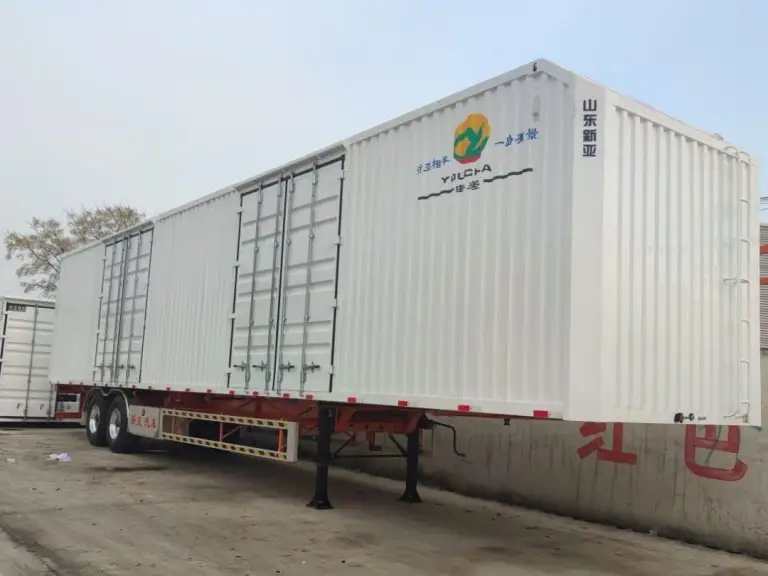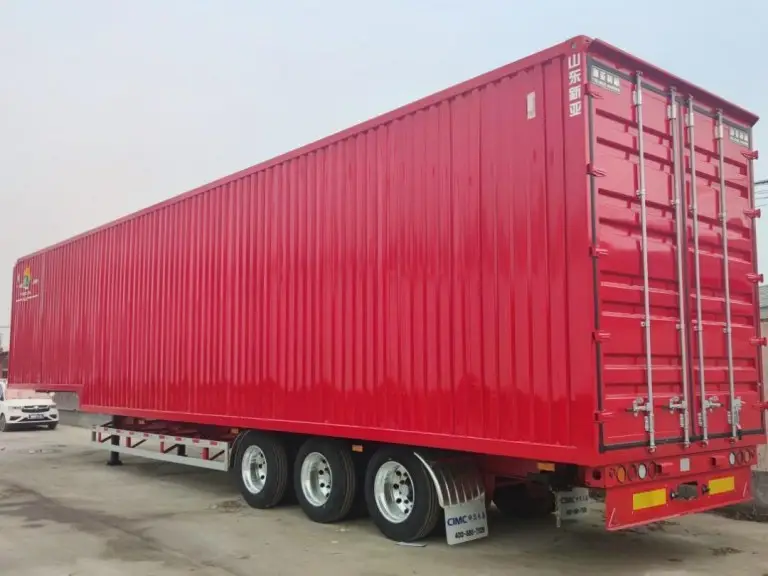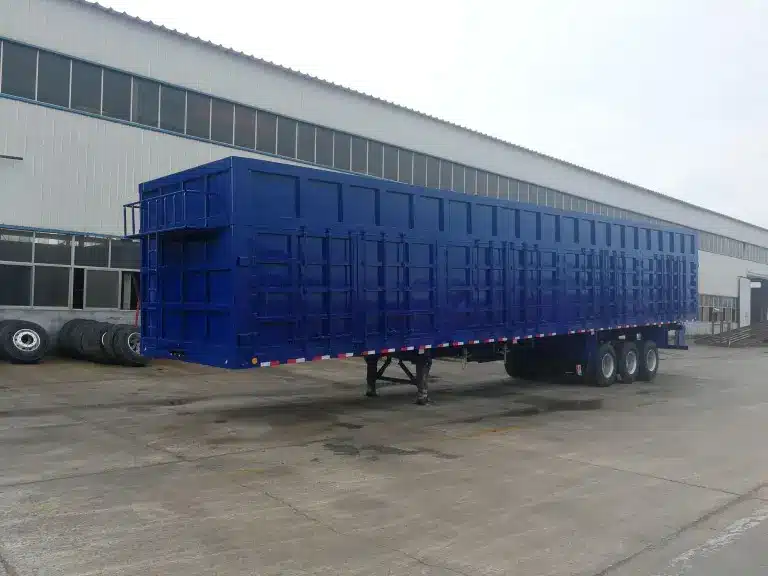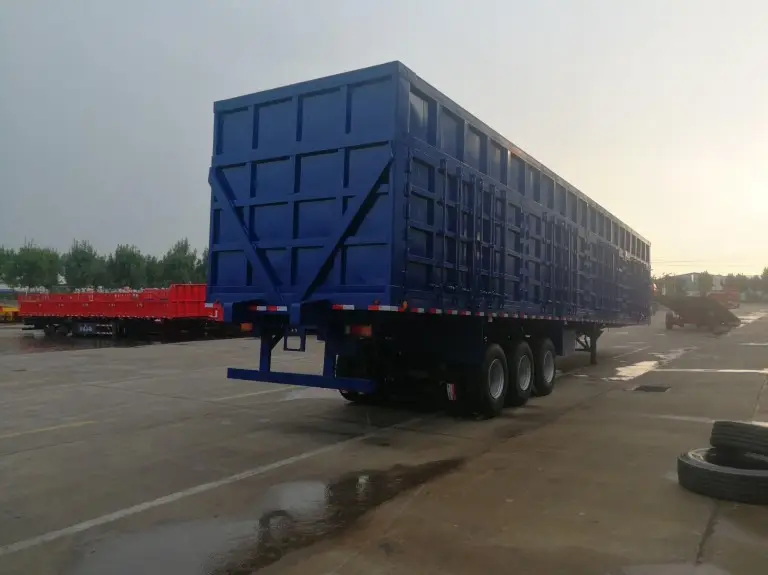In the logistics and transportation industry, understanding the differences between various trailer types is crucial for efficient business operations. Box semi-trailers (also known as box trucks) and dry vans are two fundamental vehicle types used for transporting goods. Although they appear similar, they have distinct differences in structure and functionality. Dry vans are typically longer, measuring 13 meters or 17.5 meters, and are designed specifically for transporting large goods on highways. This article will explore the basic differences between box semi-trailers and dry vans, helping you make informed decisions based on your transportation needs.
Table of Contents
Semi-Trailers and Dry Vans
In the field of freight transportation, box semi-trailers and dry vans are essentially the same solution, both falling under the category of enclosed semi-trailers, suitable for protecting cargo from external environmental influences.
What Is a Box Semi-Trailer?
A box semi-trailer is an enclosed trailer pulled by a tractor, with its core design featuring a sturdy box shell that effectively blocks rain, wind, and dust. This type of trailer is highly practical and can handle various cargoes, such as machinery, palletized goods, or consumer products, typically made from durable materials like fiberglass PET or fiberglass plywood to ensure reliable load-bearing performance. This trailer excels in handling non-temperature-sensitive cargo because it balances protection and capacity needs without requiring additional refrigeration systems.
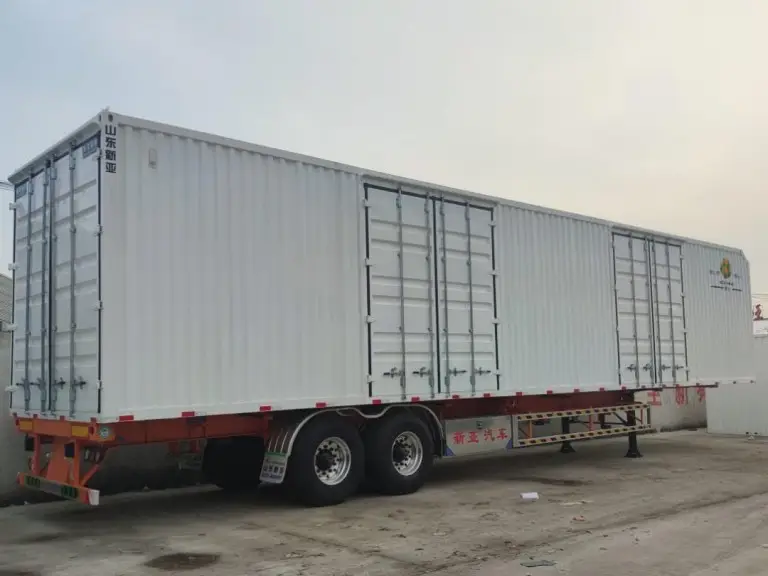
What Is a Dry Van?
A dry van is essentially the same as a box semi-trailer, also an enclosed semi-trailer optimized for long-distance transportation. Its box structure is tightly sealed, usually ranging from 48 to 53 feet in length, constructed from materials like fiberglass PET or fiberglass plywood. It is particularly suitable for transporting large volumes of goods, machinery, and palletized items, providing comprehensive weather protection. Dry vans are widely used in intercontinental or cross-regional logistics, benefiting from their durability and versatility. The uniform features of this trailer make it a reliable choice for long-haul freight.
Distinguishing from Box Trucks
Although box semi-trailers and dry vans are the same category of products, they have essential differences from box trucks. A box truck is an independent single-unit vehicle with a box body mounted directly on the chassis, rather than being pulled by a tractor. This makes box trucks more suitable for local or regional tasks, rather than large-scale long-distance transportation. The following table summarizes the key comparisons:
| Feature | Dry Van/Box Semi-Trailer | Box Truck |
|---|---|---|
| Vehicle Type | Enclosed semi-trailer pulled by a tractor | Independent single-unit straight truck |
| Primary Use | Long-distance bulk cargo transportation | Local or regional delivery |
| Size | Typically about 53 feet long | Varies in length, but commonly around 24 feet |
| Capacity | Can withstand loads up to 45,000 pounds | Typically limited to 10,000 pounds |
Begin with a bespoke semi-trailer designed for your exact needs. Whether it’s heavy-duty hauling or specialized cargo, we’ve got the perfect solution to keep you moving forward.
Structural Differences
Box semi-trailers and dry vans each have unique structural features. Understanding these differences is crucial for selecting the right trailer for specific transportation needs. Structural differences not only affect durability but also directly relate to operational costs and efficiency, for example, the larger volume of dry vans suits bulk transportation, while the compact design of box semi-trailers is more suitable for urban navigation.
Design and Construction
Box semi-trailers and dry vans have significant differences in design and construction. Dry vans are typically enclosed trailers with a rigid structure, designed to protect cargo from external elements. They are often used for long-haul transportation and are suitable for high-volume shipments. On the other hand, box semi-trailers (also known as box trucks) have a more flexible design, applicable to various cargo types and sizes. The construction of dry vans emphasizes durability and security, with features like reinforced walls and secure locking systems. Box semi-trailers, while also secure, are designed with maneuverability in mind, making them suitable for urban environments and short-distance transport.
Size and Dimensions
One of the most significant differences between box semi-trailers and dry vans lies in their size and dimensions. Dry vans can be as long as 53 feet (about 16 meters) and have the capacity to carry loads up to 20 tons, making them giants in the trucking industry. In contrast, box semi-trailers are generally shorter, with lengths ranging from 4.2 meters to 8 meters, and carry less than half the weight capacity of a dry van. These size differences directly impact their maneuverability and the types of cargo they can efficiently transport. While larger dry vans excel on highways and for long-distance transport, smaller box semi-trailers are more agile in urban environments. These dimensional differences also influence loading dock compatibility, warehouse access, and other practical considerations in the transportation process.
Further Reading:Semi Box Trailer Dimensions
Load Capacity
The weight capacity of a trailer is a key factor in determining its suitability for various transportation tasks. When transporting goods, understanding the trailer’s load capacity is essential for ensuring safe and efficient logistics.
Box Semi-Trailer Weight Capacity
Box semi-trailers are designed to carry a wide range of goods, from consumer products to industrial equipment. The weight capacity of these trailers varies based on their design and construction. Typically, a box semi-trailer can handle substantial loads but may not match the capacity of dry vans. Understanding the specific weight capacity of your box semi-trailer is crucial for effectively planning and executing transportation tasks. Factors such as the trailer’s material, size, and axle configuration play significant roles in determining its weight capacity. By knowing these specifications, businesses can better assess their transportation needs and choose the most appropriate trailer.
Dry Van Weight Capacity
Dry vans are renowned for their impressive weight capacity, often capable of carrying loads up to 20 tons. This makes them suitable for high-volume shipments and long-distance transportation of heavy goods. The design and construction of dry vans, including their complex design and specialized accessories, contribute to their strong load-bearing capabilities. Dry vans are particularly suited for transporting large quantities of goods, machinery, and palletized freight. Proper weight distribution is essential to maximize their capacity while maintaining safety on the road. Businesses with high-volume shipping needs can significantly benefit from the economies of scale provided by dry vans.
Box Semi-Trailer vs Dry Van: Key Differences
When choosing between a box semi-trailer and a dry van, understanding their key differences is crucial for efficient logistics operations. Both types of trailers have unique advantages and are suited for different tasks, with the selection process depending on various factors, including maneuverability, weather protection, security, and loading/unloading capabilities. Here is a summary list of key differences:
- Maneuverability and Flexibility: Box trucks are more flexible and maneuverable compared to dry vans.
- Weather Protection and Security: Both provide protection from elements, but design affects security features.
- Loading/Unloading Capabilities: Box semi-trailers are more suitable for urban areas, while dry vans rely on docks.
Maneuverability and Flexibility
Box trucks are more flexible and maneuverable than dry vans. Their shorter length makes them easier to turn and park, especially in urban environments. This flexibility is a significant advantage for businesses that require frequent deliveries in congested city areas. Additionally, box trucks are often equipped with a rear tail lift, facilitating easier loading and unloading of cargo, even without loading docks. The interior of box trucks typically includes E-tracks, which help secure cargo during transit. This feature is particularly beneficial for multi-stop delivery routes where cargo is frequently loaded and unloaded. In contrast, dry vans, while capable of carrying large volumes of cargo, generally have lower maneuverability and rely on loading docks and warehouse equipment for loading and unloading operations.
Weather Protection and Security
Box semi-trailers and dry vans both provide protection from elements, safeguarding cargo from weather conditions. However, the design and construction of these trailers can impact their security features. Box trucks, with their enclosed bodies, offer a high level of security, especially when equipped with additional measures like locks and alarms. Dry vans also provide secure transportation, but their larger size may require extra security considerations. In extreme weather, both require regular inspections to ensure seal integrity.
Loading/Unloading Capabilities
The loading and unloading capabilities of box semi-trailers and dry vans differ significantly, affecting operational efficiency. Box trucks are designed with features like tail lifts and E-tracks, making them highly versatile for urban distribution and capable of handling diverse tasks. In contrast, dry vans typically rely on loading docks and warehouse equipment, making them more suited for larger cargo volumes and controlled environments. Box trucks equipped with tail lifts provide significant advantages for loading/unloading in locations without docks. Their internal securing systems, like E-tracks, keep cargo secure during transit, which is crucial for multi-stop routes. Dry vans depend on loading docks and warehouse equipment for efficient loading/unloading of larger cargo. The loading flexibility of box trucks contributes to their versatility in urban distribution.
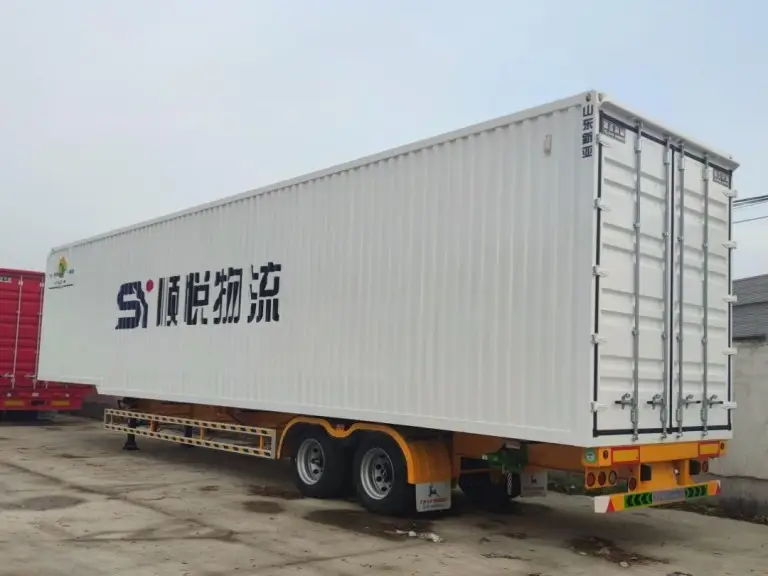
Applications
Box semi-trailers and dry vans are staples in the logistics world, with distinct applications that make them ideal for different types of cargo. Understanding their ideal uses is crucial for businesses to optimize their transportation operations. The following table summarizes key applications:
| Trailer Type | Ideal Uses | Key Benefits |
|---|---|---|
| Box Semi-Trailer | Oversized loads, construction equipment, specialized cargo | Customizable, versatile, suitable for heavy machinery |
| Dry Van | Long-distance freight, retail goods, manufacturing supplies | Efficient, secure, standardized dimensions for easy integration |
Ideal Uses for Box Semi-Trailers
Box semi-trailers are versatile and can be used for a variety of cargo types, including oversized loads and specialized equipment. They are particularly useful for construction projects, where heavy machinery and building materials need to be transported to and from sites. One of the key advantages of box semi-trailers is their ability to be customized for specific cargo needs. This makes them an excellent choice for industries that require tailored transportation solutions.
Ideal Uses for Dry Vans
Dry vans are ideal for long-distance and intercontinental transportation, where their large capacity and efficiency make them the preferred choice for moving substantial volumes of freight. They are particularly suited for retail goods, manufacturing supplies, packaged products, and palletized freight. The design of dry vans, with secure compartments and ample space, makes them ideal for valuable goods that need protection during long-distance transport. Additionally, the standardized dimensions of dry vans integrate seamlessly with warehouse operations, loading docks, and intermodal transportation systems.
How to Choose Between a Box Semi-Trailer and a Dry Van
When selecting the right trailer for your freight, understanding the differences between box semi-trailers and dry vans is crucial. Both play vital roles in logistics, but the choice depends on various factors related to your business operations and needs. Here is a selection guide:
- Assess cargo type and volume.
- Consider routes and distances.
- Analyze costs and efficiency.
Assessing Your Transportation Needs
To make an informed decision, you first need to assess your transportation requirements. Consider the type of goods you transport, the frequency of your shipments, and the typical routes you take. For instance, if you often deal with large volumes of dry goods, a dry van might be more suitable due to its capacity and protection against elements. On the other hand, if your shipments require more flexibility or you operate in various conditions, a box semi-trailer could offer the versatility you need. Understanding your specific needs will help you choose the trailer that best aligns with your business model. Through this assessment, businesses can avoid additional costs caused by mismatches.
Long-Term Business Considerations
Beyond immediate needs, it’s essential to consider long-term business implications. This includes evaluating the scalability of your chosen trailer type as your business grows, as well as financial considerations such as resale value, depreciation, and maintenance costs. Market trends and industry developments, like changes in e-commerce or environmental regulations, can also impact the viability of your trailer choice. By considering these factors, you can develop a flexible fleet strategy that supports sustainable growth and maximizes business opportunities. Whether you opt for a box semi-trailer, a dry van, or a combination of both, your choice should position your business for success in the evolving logistics landscape.
Begin with a bespoke semi-trailer designed for your exact needs. Whether it’s heavy-duty hauling or specialized cargo, we’ve got the perfect solution to keep you moving forward.
Conclusion
When deciding between a box semi-trailer and a dry van, understanding their unique characteristics is crucial. This article has explored the key differences between these two essential forms of transportation in logistics. We have seen that box semi-trailers excel in urban environments, offering flexibility, maneuverability, and accessibility for multi-stop routes. On the other hand, dry vans are ideal for long-distance transportation, high-volume shipping, and efficiency in moving large quantities of goods across highways and between distribution centers. The choice between a box semi-trailer and a dry van ultimately depends on your specific business needs, transportation requirements, and operational context. It’s worth noting that many successful logistics operations utilize both trailer types to handle different aspects of their transportation needs, creating a complementary fleet strategy. At Genron International Trade, we specialize in semi-trailer design and production, particularly semi box trailers for sale, and offer customization capabilities to help businesses find the perfect transportation solution for their unique needs. If you’re looking for more information about our semi-trailer manufacturing services or would like to discuss your specific transportation requirements, we invite you to contact us.
FAQ
What Is the Main Difference Between a Box Semi-Trailer and a Dry Van?
The primary difference lies in design and functionality. Box semi-trailers are typically used for short-distance routes and are more versatile, while dry vans are used for long-distance transportation of large volumes of goods. Both provide protection, but they differ in size and maneuverability.
What Type of Cargo Is Best Suited for a Dry Van?
Dry vans are ideal for transporting dry goods, such as electronics, clothing, and furniture, that do not require refrigeration or special handling. They are also suitable for cargo that needs to be kept dry and secure. During long hauls, they ensure cargo integrity.
How to Choose Between a Box Semi-Trailer and a Dry Van for My Business?
When deciding, consider factors such as cargo type and quantity, transportation distance and routes, and budget. Assessing your transportation needs and long-term business considerations will help you make an informed decision.
Can Dry Vans Be Customized for Specific Cargo or Industries?
Yes, dry vans can be customized with various features, such as shelving, tie-downs, or climate control, to accommodate specific cargo types or meet industry requirements. This improves efficiency and safety.
What Are the Key Considerations for Maintaining a Box Semi-Trailer or Dry Van?
Regular maintenance is crucial to ensure vehicle longevity and safety. Key considerations include routine inspections, tire maintenance, and promptly addressing any repairs or issues. Scheduled maintenance can prevent downtime.
Further Reading:Box Semi Trailer Maintenance
How Do Weather Conditions Affect Cargo Transportation in a Box Semi-Trailer or Dry Van?
Both are designed to protect cargo from elements. However, extreme weather conditions, such as high temperatures or heavy rain, may require additional precautions or specialized equipment to ensure safe transportation. Regular seal inspections are key.
What Are the Benefits of Using a Dry Van for Regional or Local Transportation?
Dry vans are often used for regional or local transportation due to their versatility, maneuverability, and ease of loading/unloading. For short routes, they are generally more cost-effective than box semi-trailers. Despite being larger, they perform efficiently in controlled environments.

